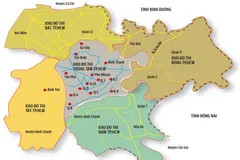
At present, domestic construction contractors are all shunning public investment projects so as to avoid this loss. Mr. NGUYỄN QUỐC HIỆP, Chairman of the Vietnam Association of Construction Contractors (VACC), spoke with Saigon Investment on these related issues.
JOURNALIST: - Sir, the disbursement rate of public investment projects in the first six months and the progress of all infrastructure works is going very slow. One of the reasons given is related to construction contractors shying from these projects. What is your opinion on this current situation?
Mr. NGUYỄN QUỐC HIỆP: - First of all, it is necessary to confirm that this delay is not the fault of construction contractors but has been caused by objective reasons.
For this delay there are two main problems. Firstly, public investment projects such as highway projects and the operating unit price system are too outdated and reveal many inadequacies. Required effective regulations do not exist, while old regulations do not keep up with the situation of the current market. At present, public investment projects are required to apply standard unit prices for costs, jobs, etc., but unit prices of input materials are updated and applied by provinces and cities. Public investment projects involve budget capital, but localities have limited budget or even retain part of the budget. Therefore, they do not update prices but often offer lower than the actual market price, making it difficult for contractors to meet their running costs.
Secondly, inflation has caused the cost of raw materials, fuel, and many materials to increase too high, leading to the cost of transportation and logistics being inflated many times over. Hence, even though enterprises have won the bid, they cannot afford it. Recently, I attended a meeting with about 20 construction contractors specializing in highways, all of whom complained that the financial situation was indeed dire. The units that are already in the construction projects are making more and more losses. As in the case of Vinaconex constructing the highway project of Highway 45 through Mai Son in Hoa Binh province, from the time the price was awarded for the contract, they have suffered a loss of 46% so far.
Also in the last two years, the price of input materials such as soil, stone, cement, and asphalt have increased exorbitantly, which enterprises must bear totally. However, due to a lack of a price compensation mechanism, construction contractors participating in public investment projects are very wary. For other types of projects, when the investor sees an increase in input costs, they can sell higher output products to compensate, while for construction contractors, which are purely into construction only, the public investment projects cannot increase rates.
- Sir, many enterprises constructing public investment projects said that they are still afraid of a long-term capital backlog. How can this problem be resolved?
- This is a situation that has continued for many years, causing headaches for many construction contractors. In the current payment mechanism, there are still many problems. The procedure for delivery and receipt of contracts with the advance payment mechanism is still easy, but it is very complicated when paying in volume. Contractors often borrow from banks at 9% to 10% interest per year, but the final payment of about 20% to 25% is often not considered. If the contractor does not receive the money soon and has to bear the bank loan interest, it can result in a debt stack. This leads to a very difficult financial situation for both contractors and investors.
Another difficulty is that contractors also have restricted credit room. Many banks do not have a credit room, making the financial situation of construction contractors even worse. If you follow the normal unit price, and do it very closely and manage it well, the business will have a profit margin of about 4%. But now due to the outstanding debt situation, the price of construction materials has increased, and without compensation more businesses are making losses.
Most construction contractors in Vietnam today have weak financial capacity, a registered capital of only VND 50 bln or VND 100 bln, and large enterprises with VND 200 bln or VND 300 bln or more are not many. With such limited financial capacity, they have to cope with the price storm, and if this situation is prolonged, the risk of bankruptcy is unavoidable.
- Sir, what solution would you suggest for solving this problem?
- The current price of materials and fuel have increased and will raise input costs by 18% to 36%. While in terms of state policy, there is still no mechanism to compensate for prices.
Therefore, firstly authorities need to soon develop and apply a price compensation mechanism close to the market price. We hope that the Law on Bidding will soon be introduced to the National Assembly to adjust, amend, and supplement as required. Currently, the procedures for contract delivery are very confusing, causing construction companies to remain baffled as to how to manage when they have to serve all factors at the same time.
Secondly, to overcome financial difficulties, it is necessary that construction companies have more credit room for capital so as to invest in construction activities when the projects have not yet been accepted or settled.
Thirdly, regulations should be limited or adjusted to be close to the ground reality of Vietnam and reduce the cost burden for contractors. For instance, currently construction companies are facing reverse regulations on fire prevention. Vietnam's fire protection standards are according to American standards and so they are almost the highest standards in the world.
There are very special requirements for fire protection materials which only a few specialized enterprises can provide, while the rest must be imported exclusively, so the price is very high. Like fireproof paint, when there was no Law on Fire Protection, the price was only VND 100,000, now it is VND 700,000. Fireproof glass before was VND 1 mln, now it is VND 20 mln. All these costs have to be borne by the contractors.
Fourthly, there is the problem of retrospective audit and inspection. There are projects that have been settled for about ten years, and now need to be re-audited to pay back the land cost. Here, enterprises face decisions made solely by local valuation agencies. This responsibility belongs to localities even if there is a mistake.
As for the construction contractor, after several years of the project, the finalization documents have to be completed, everyone divides the profits, but then they are told to collect this and that, and the business has to pay for it all. Therefore, the regulation should shorten the time for retrospective inspection and examination to five years, so that enterprises can feel secure in doing business in the future.
- Thank you very much.




















